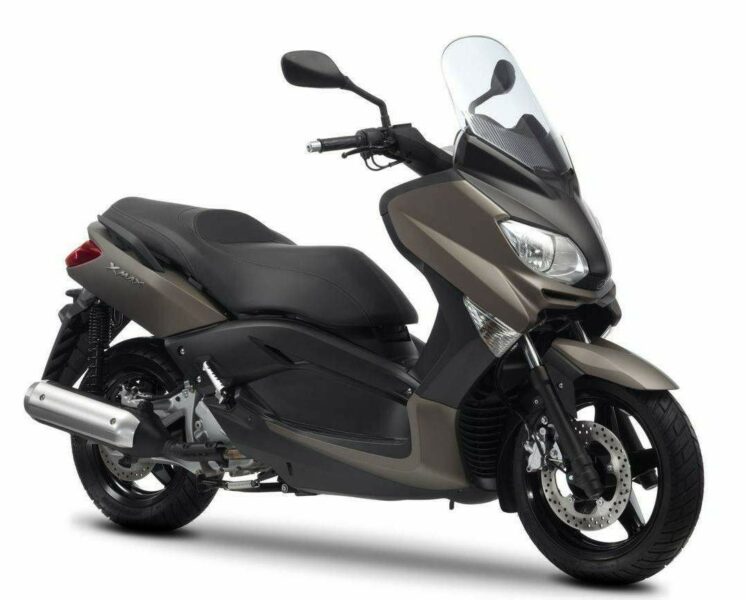
Yamaha X Max 250
The term "sporty" is, of course, to be taken with a grain of salt. The X-max is by no means a racing car, it has nothing to do with driving on a kart track or, God forbid, real race tracks.
This is a mid-size maxi scooter (Yamaha's offer ends at a 500cc T-Max, which costs about ten thousand) with sporty exterior lines, with a pronounced center protrusion (no, you won't be able to ride on boxes). ), a very large, long red-stitched seat for two, with solid wind protection and a 250cc single-cylinder engine capable of delivering 15 kilowatts in front of the rear wheel.
If we compare it to its competitors (like the Piaggio Beverly) the difference is clear: the Italians put more emphasis on sleek design, albeit at the expense of usability – this Yamaha has space under the seat for two jet helmets!
For such a large clearance under the seat, in addition to the wide rear and clever but stylistically less pleasant rear shock mounts, the smaller wheel is also to blame for the rear of the bike. Wheel size (front 15, rear 14 ") is average between small scooters with a diameter of 12" or more, almost motorized 16 "wheels.
This is reflected in a ride with very good driving characteristics, only the comfort when driving over bumps is still not as good as on scooters with even larger wheels. The wheels are a little crooked, the suspension is a little harsh.
A pair of rear shocks can be pre-tensioned, as noted, but they are nearly vertical, whereas usually the rear shocks are tilted forward as the rear swingarm travels in a circle rather than a straight line. in the vertical direction. Unusual and not too pretty.
Otherwise, the final production of this scooter is at a high level. Both the plastic and the red-stitched seat give the impression that they won't fall apart or tear after a few months of use, which is the exception rather than the rule for some (otherwise cheaper) Oriental goods.
The steering wheel is high enough not to be touched by the knees, and due to the shape of the plastic along the middle ridge, the driver can choose a position behind him at will. He can sit up straight with his feet flat at the bottom, or he can squat and stretch his legs forward.
The passenger has nothing to complain about the size of the seat and handles, only they will have to go moderately slowly over the covers of the road shafts. Or avoid them – thanks to the strong carcass, quick change of direction is a pleasant and safe experience. The brakes are good too - not too aggressive, not too weak, just right.
The engine with electronic injection has always started well and proved to be alive in the city, and at a speed of about 100 kilometers per hour it starts to run out of breath. Under favorable conditions, it can also reach speeds of up to 130 kilometers per hour.
The fuel consumption of the four-stroke engine was acceptable - from four to five liters per hundred kilometers in the city and its environs. The fuel tank is so big that you can jump into Portorož if you want. And not on the track, because mountain walks on this scooter will be very interesting.
Technical information
Test car price: 4.200 EUR
engine: single-cylinder, four-stroke, liquid-cooled, 249 cm? , electronic fuel injection, 78 valves per cylinder.
Maximum power: 15 kW (20 km) at 4 rpm
Maximum torque: 21 Nm @ 6.250 rpm
Energy transfer: clutch automatic, variomat.
Frame: steel pipe.
brakes: front coil? 267mm rear coil? 240 mm.
Suspension: front classic telescopic fork, 110 mm travel, rear two shock absorbers, adjustable preload 95 mm.
Tires: 120/70-15, 140/70-14.
Seat height from ground: 792 mm.
Fuel tank: 11, 8 l.
Wheelbase: 1.545 mm.
Weight (with fuel): 180 kg.
Representative: Delta Team, Cesta krških žrtev 135a, Krško, 07/492 14 44, www.delta-team.com.
We praise and reproach
+ nice shape
+ live engine
+ solid workmanship
+ place behind the wheel
+ large luggage compartment
– less comfortable driving over bumps
Matevž Gribar, photo: Aleš Pavletič
